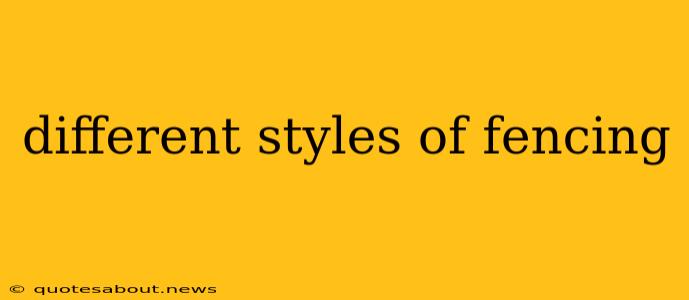Fencing, a captivating blend of athleticism, strategy, and precision, boasts a rich history and diverse range of styles. Understanding the nuances of each style is key to appreciating the sport's depth and complexity. This guide explores the three main Olympic fencing disciplines—foil, épée, and sabre—detailing their unique rules, techniques, and strategic approaches.
The Three Main Styles of Olympic Fencing
The world of competitive fencing centers around three distinct weapon types, each with its own scoring system and ruleset:
1. Foil
Foil fencing is characterized by its light, thrusting weapon. Only the front of the body, from the shoulders to the groin, is a valid target. Right of way, a crucial element in foil, determines which fencer scores a touch if both hit simultaneously. This intricate system adds a layer of tactical complexity, rewarding precise timing and strategic positioning.
Key Characteristics of Foil Fencing:
- Light, thrusting weapon: Emphasizes speed and finesse.
- Target area: Front of the body (from shoulders to groin).
- Right of way: A crucial element determining who scores in a simultaneous hit.
- Strategic focus: Speed, precision, and tactical footwork.
2. Épée
Épée fencing utilizes a heavier, thrusting weapon, and unlike foil, there's no right of way. Any part of the body, from head to toe, is a valid target. This makes épée fencing more straightforward in terms of scoring but demands exceptional control and reach. The heavier weapon requires more strength and endurance, leading to a more physically demanding style of play.
Key Characteristics of Épée Fencing:
- Heavy, thrusting weapon: Requires strength and control.
- Target area: Entire body.
- No right of way: Simpler scoring but demanding precision.
- Strategic focus: Control, reach, and calculated attacks.
3. Sabre
Sabre fencing is the most dynamic of the three Olympic disciplines, employing a curved, cutting and thrusting weapon. Both cutting and thrusting actions are valid, and the entire body, above the waist, is a target. The rapid-fire nature of sabre bouts demands incredible speed, reflexes, and a high level of aggression. This style is known for its explosive exchanges and thrilling finishes.
Key Characteristics of Sabre Fencing:
- Curved, cutting and thrusting weapon: Allows for diverse attacks.
- Target area: Entire body above the waist.
- Emphasis on speed and aggression: Requires quick reactions and explosive movements.
- Strategic focus: Speed, cutting actions, and aggressive offense.
Beyond the Olympics: Exploring Other Fencing Styles
While foil, épée, and sabre dominate the Olympic stage, the world of fencing extends beyond these three disciplines. Historically, many other weapon types and styles existed, and some continue to be practiced today. These include:
- Historical European Martial Arts (HEMA): These styles reconstruct fencing techniques from various historical periods, using replica weapons. This offers a fascinating insight into the evolution of fencing.
- Classical Fencing: This often refers to the older methods and techniques of foil, épée, and sabre, emphasizing certain principles and styles that have evolved over time.
Choosing Your Style: Finding the Right Fit
The best style of fencing for you depends on your individual preferences and physical attributes. If you value precision and strategy, foil may be your ideal choice. Those seeking a more physically demanding style might gravitate towards épée. And if you thrive on speed and aggression, sabre is likely to be the most exciting option. Ultimately, the best way to decide is to try each style and see which one resonates with you the most. Many fencing clubs offer introductory classes that allow you to explore the different disciplines before committing to one.

